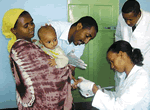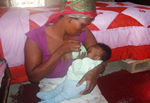Antiretroviral
Therapy for Mothers Improves Pregnancy Outcomes and Reduces Risk of HIV Transmission
via Breast-feeding
 | The
benefits of long-term combination antiretroviral therapy (ART) for pregnant women
and new mothers was a key theme at the 5th International AIDS Society Conference
on HIV Pathogenesis, Treatment, and Prevention last month in Cape Town, South
Africa. Several studies showed that combination ART leads to improved birth outcomes
and extended treatment of mothers and babies reduces the risk of HIV transmission
during breast-feeding. |
By
Liz Highleyman One
of the first major antiretroviral drug success stories was the use of zidovudine
(AZT; Retrovir) monotherapy to dramatically lower the rate of mother-to-child
HIV transmission during pregnancy and delivery. In
high-income countries such as the U.S.,
HIV positive pregnant women are urged to use a complete ART
regimen to achieve full viral load suppression, rather than single or dual
drugs, and are advised not to breast-feed their infants. The latest treatment
guidelines, in fact, recommend that all pregnant women with HIV should receive
combination ART. | In
resource-limited countries such as those in sub-Saharan Africa -- where HIV prevalence
among pregnant women may reach as high as 50% -- expectant mothers are still often
treated with the ACTG 076 regimen of zidovudine monotherapy during pregnancy and
labor, and for the infant for 6 months after birth. Women who do not receive prenatal
care prior to delivery may be given a single dose of nevirapine
(Viramune). Combination ART is often reserved for people with a CD4 cell count
below 200 cells/mm3 -- as opposed to the U.S. threshold of 350 cells/mm3 -- or
clinical symptoms of immune suppression. | |
Furthermore,
due to competing risks related to unclean water and inadequate nutrition, the
World Health Organization (WHO) advises HIV positive mothers to breast-feed exclusively
for 6 months if replacement feeding is not "acceptable, feasible, affordable,
sustainable, and safe." But
studies increasingly show -- and advocates increasingly demand -- that pregnant
and breast-feeding women in low-income countries should receive the same standard
of care as those in high-income areas: full combination ART using effective and
well-tolerated drugs. Several studies presented in Cape Town support such a paradigm
shift. Mma
Bana Study | The
Mma Bana study included 560 HIV positive pregnant women in Botswana with a CD4
cell count above 200 cells/mm3 (median about 400 cells/mm3). Starting between
26 and 34 weeks of gestation and continuing through 6 months after delivery, the
women were randomly assigned to receive either 3 nucleoside/nucleotide reverse
transcriptase inhibitors (NRTIs) -- zidovudine, lamivudine, and abacavir in the
Trizivir fixed-dose coformulation
-- or else the protease inhibitor lopinavir/ritonavir
(Kaletra) plus zidovudine/lamivudine
in the Combivir coformulation. |  |
In
addition, another 170 women with a CD4 cell count < 200 cells/mm3 (median about
150 cells/mm3) started zidovudine/lamivudine plus nevirapine, which is not recommended
for women with CD4 counts > 250 cells/mm3. All
the women also received extra zidovudine during labor. All infants received a
single dose of nevirapine after delivery and zidovudine for 4 weeks. At
the time of delivery, 96% of women taking Trizivir, 93% of those taking lopinavir/ritonavir,
and 94% of those taking nevirapine had HIV RNA < 400 copies/mL. Furthermore,
similar percentages also maintained virological suppression during breastfeeding
(92%, 93%, and 95%, respectively). Rates
of mother-to-child HIV transmission were very low in women taking all 3 regimens:
1.8% with Trizivir, 0.4% with lopinavir/ritonavir, and 0.6% with nevirapine, differences
that did not reach statistical significance. Most cases of transmission occurred
during pregnancy and from women with higher baseline viral loads and shorter durations
of ART prior to delivery. However, 2 cases occurred during breast-feeding in the
Trizivir arm, including 1 from a woman with HIV RNA < 50 copies/mL. Birth
outcomes were good overall. However, women taking lopinavir/ritonavir were significantly
more like to give birth prematurely (25%, compared with 15% taking Trizivir and
10% taking nevirapine) and women on nevirapine were more likely to have still-births
(7%, compared with 3% in the Trizivir group and 2% in the lopinavir/ritonavir
group). Infant mortality was 2%-4% across the 3 arms. 13% of infants born to women
in the Trizivir group, 17% in the lopinavir/ritonavir group, and 15% in the nevirapine
group had a low birth weight. This
study -- with the lowest rate of mother-to-child transmission seen to date in
a randomized study of HIV treatment during pregnancy and breast-feeding in a resource-limited
setting -- demonstrated that extended combination ART is highly effective in preventing
vertical transmission. Beth
Israel Deaconess Medical Center, Harvard University, Boston, MA; Harvard School
of Public Health, Boston, MA; Botswana-Harvard AIDS Institute, Gaborone, Botswana;
Brigham and Women's Hospital, Boston, MA; Massachusetts General Hospital, Boston,
MA; National Institutes of Health, National Institute of Allergy and Infectious
Diseases, Bethesda, MD; GlaxoSmithKline, Greenford, UK; Abbott Virology, Miami,
FL; Botswana Ministry of Health, Gaborone, Botswana. BAN
Study | The
BAN (Breastfeeding, Antiretroviral and Nutrition) study included 2367 HIV positive
mothers in Malawi with a CD4 count > 250 cells/mm3. All women received single-dose
nevirapine during labor followed by zidovudine/lamivudine for 1 week. The overall
rate of mother-to-child HIV transmission was 5%. |  |
A
week after birth, mother-infant pairs were randomly allocated into 3 groups receiving
either maternal therapy with zidovudine/lamivudine plus lopinavir/ritonavir (no
infant therapy), or infant treatment with nevirapine monotherapy for 28 weeks
(no maternal therapy), or no further ART for either mother or baby (enrollment
in the control arm was halted early). All women also received nutritional supplements. All
mothers breast-fed for 6 months than rapidly weaned their babies within 1 month
using a special weaning food provided by the study. By
the end of 28 weeks, the rate of mother-to-child HIV transmission was 1.8% in
the infant nevirapine arm and 3.0% in the maternal ART arm, both significantly
lower that the 6.4% rate in the untreated arm. Similarly, the risk of a combined
endpoint of HIV transmission or infant death was 2.9% in the infant nevirapine
arm, 4.7% in the maternal ART arm, and 7.6% in the untreated arm. Severe
side effects were uncommon, with no differences in severe (grade 3 or 4) toxicities
across the 3 arms, including adverse events related to nevirapine hypersensitivity
reactions. UNC
Project, Lilongwe, Malawi; University of North Carolina, Chapel Hill, NC; U.S.
Centers for Disease Control and Prevention, Division of Reproductive Health, Atlanta,
GA; Principia International, Chapel Hill, NC; Kamuzu Central Hospital, Lilongwe,
Malawi. Kesho
Bora Study
 Conducted
in Kenya, South Africa, and Burkina Faso, the Kesho Bora study included 824 HIV
positive pregnant women with a CD4 count between 200 and 500 cells/mm3. Conducted
in Kenya, South Africa, and Burkina Faso, the Kesho Bora study included 824 HIV
positive pregnant women with a CD4 count between 200 and 500 cells/mm3.
Participants
were randomly assigned to receive either extended combination ART consisting of
zidovudine/lamivudine plus lopinavir/ritonavir from the third trimester through
6 months after delivery (at which point they were advised to stop breast-feeding),
or else short-course treatment with zidovudine monotherapy from week 28-36 of
gestation until 1 week after delivery, plus single-dose nevirapine at the time
of delivery. All infants received single-dose nevirapine after delivery and zidovudine
for 1 week. Women
were given the option of receiving free formula or exclusively breast-feeding
for 6 months with rapid weaning; about 77% of women in both arms breast-fed at
some point -- for an average duration of 21 weeks -- and about 45% breast-fed
exclusively for the first 3 months. At
all time points, HIV transmission rates were lower in the combination ART arm
compared with the short-course therapy arm: 1.8% vs 2.2% at birth, 3.3% vs 4.8%
at 6 weeks, 4.9% vs 8.5% at 6 months, and 5.5% vs 9.5% at 1 year. Overall, this
accounted for a 42% risk reduction in the combination therapy arm. Looking
at infant mortality, 6.3% of babies born to mothers in the combination arm died
during the first year, compared with 10.0% of infants in the short-course therapy
arm, a 37% risk reduction (though it did not reach statistical significance).
Further
analysis revealed that the reduced risk of transmission with combination ART was
only statistically significant among mothers with a baseline CD4 count of 200-350
cells/mm3, not those with 350-500 cells/mm3. The
researchers emphasized that since the greatest benefit was seen in women with
200-350 cells/mm3, this group should be a priority for expanded treatment efforts. World
Health Organization, Department of Reproductive Health and Research, Geneva, Switzerland. DREAM
Study  A
retrospective analysis of the DREAM (Drug Resource Enhancement against AIDS and
Malnutrition) program also showed that extended maternal ART continuing during
breast-feeding reduced the risk of mother-to-child HIV transmission. A
retrospective analysis of the DREAM (Drug Resource Enhancement against AIDS and
Malnutrition) program also showed that extended maternal ART continuing during
breast-feeding reduced the risk of mother-to-child HIV transmission.
DREAM
offers HIV care and treatment for some 75,000 adults and children in 10 sub-Saharan
African countries. Pregnant women in the program with a CD4 cell count below 350
cells/mm3 receive nevirapine plus either zidovudine/lamivudine or stavudine/lamivudine
starting at week 14 of gestation and continuing indefinitely. Women with higher
CD4 cell counts receive the same regimen from week 25 of gestation until the end
of weaning (closer to recommendations in high-income countries, except for breast-feeding). In
an analysis of nearly 3000 infants with available test results at 1 month after
birth, the transmission rate was 0.7%. As transmissions due to breast-feeding
added up, the cumulative rate rose to between 1.4% and 1.9% at 6 months. The cumulative
6-month infant mortality rate was 2.1% (nearly 8% of infants were lost to follow-up). Not
surprisingly, the researchers found that the transmission rate was significantly
lower for women who received at least 1 dose of ART before delivery compared with
those first treated during delivery (0.9% vs 5.5%). In
contrast with the Kesho Bora study, the reduction in transmission associated with
ART was seen at all CD4 counts, though overall rates were lower at higher maternal
CD4 levels. Among women with < 350 cells/mm3, the combined 6-month rates of
HIV transmission or infant death were 3.1% with > 30 days of maternal ART vs
8.8% with < 30 days. For women with 350 cells/mm3, the corresponding
rates were 1.8% vs 2.1%, respectively. Based
on these findings, the researchers concluded, "The benefits of HAART during
pregnancy for HIV-1 [prevention of mother-to-child transmission] are extensive
to women with higher CD4 counts. Best results occur with longer duration of treatment." The
DREAM team also reported that other pregnancy outcomes were improved among mothers
who took combination ART for more than 30 days compared with those treated for
a shorter period or not at all. Maternal mortality rates were 0.7% vs 7.4% in
the extensively treated and minimally treated groups, and spontaneous abortion/still-birth
rates were 4.3% vs 25.7%, respectively. The
researchers concluded that "HAART was strongly associated with improved pregnancy
outcomes including reduction in prematurity, regardless of CD4 strata. Community
of Sant'Egidio, DREAM program, Rome, Italy; LUMSA University, Rome, Italy; University
of Tor Vergata, Public Health, Rome, Italy; DREAM Program, Community of S. Egidio,
Blantyre, Malawi; DREAM Program, Community of S. Egidio, Maputo, Mozambique; UCLA,
Pediatrics, Los Angeles, CA; DREAM Program, Community of S. Egidio, Lilongwe,
Malawi; DREAM Program, Community of S. Egidio, Balaka, Malawi; DREAM Program,
Community of S. Egidio, Rome, Italy. WHO
Guidelines Given
the growing body of data supporting extended duration combination ART for women
during pregnancy and for both mothers and infants during breast-feeding, WHO is
now reviewing its 2006 recommendations,
which currently advise short-course therapy for prevention of mother-to-child
transmission. New
guidelines are expected to be released by the end of the year, and many experts
believe they are likely to recommend combination therapy using ore drugs and longer
duration of treatment even in resource-limited settings, thereby benefiting the
health of both HIV positive mothers and their children. 8/04/09 References R
Shapiro, M Hughes, A Ogwu, and others. A randomized trial comparing highly active
antiretroviral therapy regimens for virologic efficacy and the prevention of mother-to-child
transmission among breastfeeding women in Botswana (The Mma Bana Study). 5th International
AIDS Society Conference on HIV Pathogenesis, Treatment, and Prevention (IAS 2009).
July 19-22, 2009. Cape Town, South Africa. Abstract
WeLBB101. C
Chasela, M Hudgens, D Jamieson, and others. Both maternal HAART and daily infant
nevirapine are effective in reducing HIV-1 transmission during breastfeeding in
a randomized trial in Malawi: 28 week results of the Breastfeeding, Antiretroviral
and Nutrition (BAN) Study. 5th International AIDS Society Conference on HIV Pathogenesis,
Treatment, and Prevention (IAS 2009). July 19-22, 2009. Cape Town, South Africa.
Abstract
WeLBC103. I
de Vincenzi and others (Kesho Bora Study Group). Triple-antiretroviral prophylaxis
during pregnancy and breastfeeding compared to short-ARV prophylaxis to prevent
mother-to-child transmission of HIV-1: the Kesho Bora randomized controlled clinical
trial in five sites in Burkina Faso, Kenya and South Africa. 5th International
AIDS Society Conference on HIV Pathogenesis, Treatment, and Prevention (IAS 2009).
July 19-22, 2009. Cape Town, South Africa. Abstract
LBPeC01. MC
Marazzi, G Liotta, J Haswell, and others. Extended use of highly active antiretroviral
therapy (HAART) during pregnancy in Southern Africa is highly protective in HIV-1
prevention of mother-to-child-transmission (PMTCT) also in women with higher CD4
cell counts. 5th International AIDS Society Conference on HIV Pathogenesis, Treatment,
and Prevention (IAS 2009). July 19-22, 2009. Cape Town, South Africa. Abstract
TuAC101. MC
Marazzi, L Palombi, K Nielsen-Saines, and others. Favorable pregnancy outcomes
with reduction of abortion, stillbirth, and prematurity rates in a large cohort
of HIV+ women in Southern Africa receiving highly active antiretroviral therapy
(HAART) for prevention of mother-child transmission (PMTCT). Abstract
TuAC102. Other
source
Reuters.
WHO may change ARV guidelines for pregnant mothers. July 22, 2009.
|
|